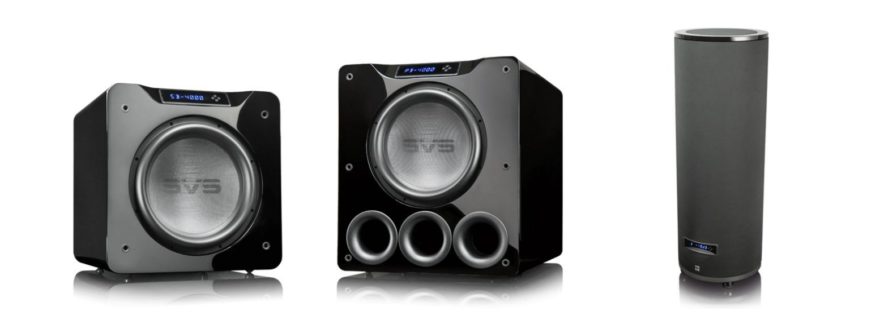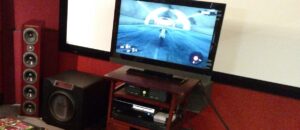As part of our recent focus on subwoofers and making better bass, we asked last week how many subwoofers you have in your home theater. Now I’d like to know what type of subs you use: sealed, ported, or cylinder?
If you’re not familiar with the differences between these types of subwoofers, I unfortunately don’t have the time to write a detailed article about it here. The short version is that ported subs are able to displace more air than sealed subs, and thus can hit deeper octaves at louder volumes. This makes them very well suited for viewers who really want the bass to slam them in the gut during a movie explosion. The trade-offs to this, however, are: 1) Ported subwoofers are physically much larger than their sealed counterparts, and thus are harder to place and eat up a bigger chunk of room space, and 2) Ported subs frequently have a steeper drop-off curve than sealed subs and may sound boomy.
Music aficionados have often argued that sealed subwoofers have a “tighter” response that reacts better to quick changes in musical tempo, and a shallow drop-off in the bottom end that sounds smoother. However, this is a not-entirely-accurate simplification. A well-designed and -engineered subwoofer of either type needs to be able to strike a balance between both music and explosions, and those from the best manufacturers manage to do that.
Cylinder subwoofers are typically ported in design, and offer the air displacement advantages of a ported sub while taking up fewer square feet. They can be pretty unobtrusive when placed in a corner. On the other hand, their taller height usually rules out putting them in the front of the room between the main speakers, because they’d block the viewing screen there.
Personally, sealed subwoofers are the most practical for me. I have a decent-sized but not huge home theater, and with all my equipment and furnishings simply don’t have any good space to put a big ported sub. I don’t think a cylinder would work out very well for me either. The only corner I have free where I might put a cylinder sub is not a very good acoustic position for a subwoofer. That doesn’t mean I have anything against ported or cylinder subs, just that the decision hinges on very pragmatic concerns in my room.






T.J. Kats
Still rocking this one.
https://www.outlawaudio.com/products/lfmEX.html
Would love to update and go duals but with three kids it never seems like a good time.
Jon
SVS PC-12 Plus in 16Hz mode. It’s a beast.
Slayer117x
HSU VTF-15H – Absolutely love it; would really enjoy a 2nd one
Scott
Not sure if you are married or not and your reason for not having a second one is the WAF. You can however tell her that some stranger on the internet told you it was okay to buy one. There’s your justification. If she has a problem with it she can reply to this post. 😉
Scott Simonian
I like this Scott fellow ^^^^^^
He’s right, you know. 😉
Slayer117x
There are probably 2 or 3 good reasons I don’t have it already, but the main one is I’m currently working on finishing my Atmos setup and upgrading my other speakers. I currently do now have any height speakers 🙁 Depending on how black friday goes I’ll either get the traditional 4 height speakers or mimic Josh with 6 height speakers.
Like your other comment I’ll be with HSU for life.
Scott
I had put in the previous poll that I have four subwoofers. Which is I’d say mostly true.
Like the poster above I became a big fan of the HSU line of subwoofers. Demoed one years ago and would not buy anything else now (unless you gave me stupid money and I could afford some JL Audio subs).
I have two HSU subs, the HSU VTF3-HO (12″) and HSU VTF-15H (15″) which do my main subwoofer duties.
I also use a pair of NHT 3.3 speakers as my front left and right speakers. These are truly full range speakers as they each have a 12″ woofer built in to them. I have each of these bi-amped for maximum bass extension. So while possibly not true subwoofers in that they are part of a tower speaker, they are more capable than what most people use as their primary subwoofer.
plissken99
I have two giant Klipsch 884 ported subwoofers. Just big boxes with an 18 inch woofer powered by an iNuke amp delivering 1500wpc.
I have excellent bass that hits in the chest very hard! To accommodate them and the rest of my crazy speakers I built the room with them in mind. In addition to normal sound panels, every bay behind the walls has Roxul safe n sound in it. And the riser I built as a giant bass trap.
Muttley
I’m running a single SVS PB-12 Plus.
It was bought in late 2007. It still brings a smile to my face.
I’ve been contemplating an upgrade to their PC-4000…but with the way the PB-12 performs, I haven’t felt the need to pull the trigger.
C.C.
About to buy dual subs for 7000 cubic foot space.
The contenders have been whittled down to Dual Next Level Acoustics CI-HV12’s or Dual Power Sound Audio 18″ V1811’s or V1510’s. (Ported)
I was pretty sold on PSA until I heard raves about Next Level Acoustic’s unique design in their subs:
“high velocity subwoofers that offer a new level of bass enjoyment with significant advantages over industry standard sealed and vented designs. The key to their performance is a two-chamber tuning system that affects both the front and back of the active woofer cone. The back chamber acts as a governor providing a sealed air restorative force that prevents power robbing ultra-low frequency decoupling (subsonic “run away”), while the front/vented portion does the actual tuning and is responsible for delivery of bass into the room. This two-part tuning mechanism provides more precise power management and constant bandwidth over conventional open-faced subwoofers (nearly 50%), while adding almost 40% greater efficiency. The thermal tolerance of the woofer’s voice coil now becomes the output limiting factor, rather than excess excursion issues, common with open-faced sealed and vented subwoofers. A single 4″ flared vent (dual on the HV12), with less than 12 grams of actual moving air mass, creates a super-fast, responsive, low frequency shock wave that energizes the room and is more faithful to the input signal than slower conventional open-faced subwoofers. This provides a higher level of detailed bass at nearly 5X the speed. The CI-HV10/HV12 is simply faster, tighter and more faithful to the input signal.”
Since PSA is only about an hour from my house – I’m going to give those a demo soon.
C.C.
Btw- Tom Vodhanel, the president of PSA was the “V” in SVS until he left to start PSA.
Scott Simonian
In other words, a 4-order bandpass enclosure.
Scott Simonian
4th-order bandpass, I mean.
These comments need an edit function. :p
C.C.
Agree! What is your opinion on this design for a sub?
Rowan611
You’re better off with the PSA. No replacement for displacement.
C.C.
Ha, ha! So you think 4th-order sub is a glorified sealed sub?
Scott Simonian
It’s both. A 4th-order bandpass has a sealed rear chamber and a vented front chamber. It’s a sealed sub with the front baffle enclosed into a resonant chamber which will apply an acoustic low-pass upon the system and increase sensitivity within a narrow range.
The main point of using a bandpass system is to achieve the most efficiency in as small an enclosure as possible while giving up most the advantages of a sealed system and a normal resonant (vented) system. The former would be less efficient and the latter would be larger than an equivalent bandpass enclosure.
C.C.
Thanks. Took the plunge. Dual CI-HV12’s.
Jeremy
SVS SB-16 Ultra! it’s an absolute BEAST!
MATTHEW BRAZLE
I have a DIY cabinet with one 18″ for lows in ported 11 cu ft and two 15″ woofers in ported 2 cu ft for mid-bass.
T.O.
HSU VTF-3 MK5. Love it! The versatility and price give you super bang for the buck.
David Adams
Charming case study but doesn’t take into account those with purpose built theaters with varying subs to cover ranges of sub bass frequencies. That said, I own no sealed subs, only ported. Varying between standard ports and cylindrical, custom setups.
Rowan611
4 THTs in my 7000+ cuft theater. Still not enough.
Mark
I’ve had my Martin Logan Depth for a while now and absolutely love it.
https://www.martinlogan.com/en/product/depthi
Scott Harpersberger
Have a svs sb 16 ultra sub. Relatively large, but tucks away nicely in the corner.
I had a ported $600 hsu sub prior which was bought about 7 years ago (I can’t recall the model number), which was good, but had its moments in sounding boomy. Understandably the svs is in a different league. This may not be the case if comparing svs’s sealed vs ported at the same price range.
JAMES L JENKINS
Hey are have a 20 year Cerwin Vega Sub150 in front, JBL SUB500 on the rear. Using Polk Audio bi-amped tsi300 front and Kenwood’s KS-505HT for rear. Yamaha Rx-A730 Network receiver. The Cerwin Vega is 15 rear dual ported and Jbl is front ported long throwing 10. For a sub that 20 years old, it does some fair work on in my room. I like me subs to sound stealthy. They a hidden and people think all the bass is coming from those polks. I would like to find another Vega and upgrade my front mains.
Jim Milton
Velodyne in-wall (12 inch) and an Earthquake CP 8 behind my seat to kick me awake upon occasion.